Fruits and Veggies Monday - Tips and GIFs for Harvesting Edible Weeds From a Garden Rehab - 11 Edible Weeds and 1 That Can Kill You!
If you know your edible weeds and these foraging tips, you could have a garden harvest even before you plant anything! It's great to get an immediate reward for a rehabbing a neglected garden area!
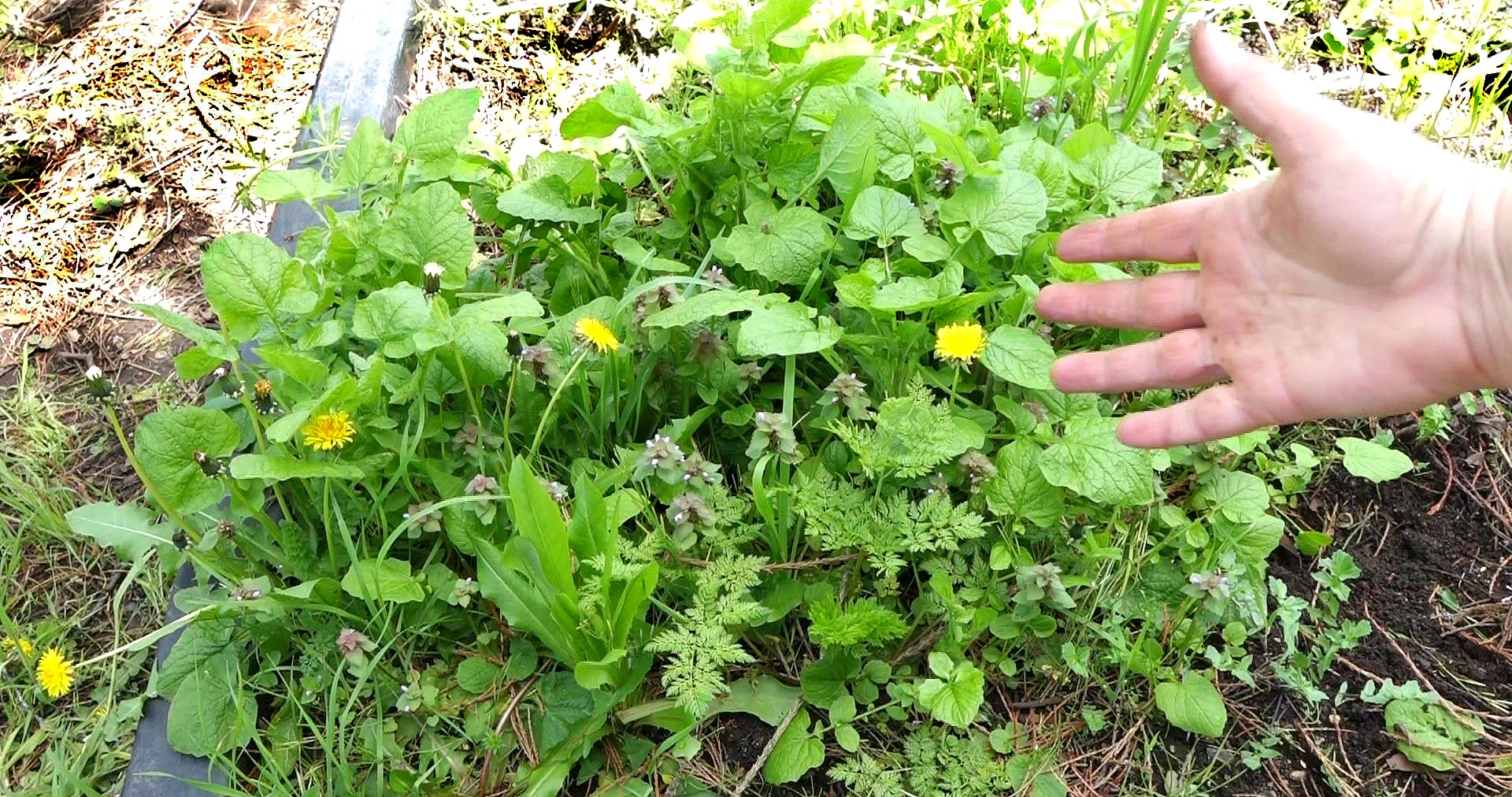

A Raised Bed Rehab Project
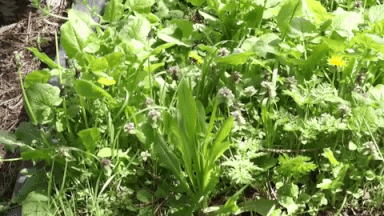

Tip 1: Pick Clean
Don't just pull a weed and toss it into a bowl or basket. Cut the roots off so the soil doesn't make it back to the kitchen. And double-check any clumps of plants to make sure there's nothing mixed in with that 1 kind of plant. After all, not every weed is edible!
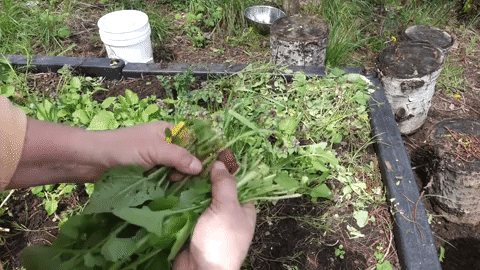.gif)
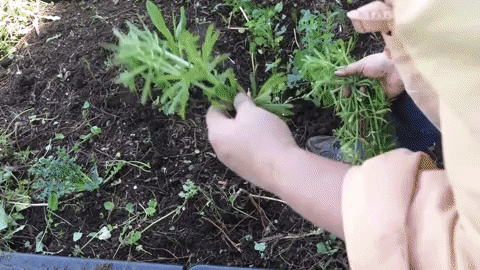.gif)

Tip 2: Pick Organized
I made a Steemit post about 2 different strategies for efficiently picking garden weeds to eat. In a garden rehab, there's often a wide assortment of weeds. So I start off with a lot of bowls to hold the different kinds of weeds that I'm picking. I keep each kind of weed in its own pile. That way, it's a lot easier to double-check the plants back in the kitchen to remove any parts that are in poor condition -- or unwanted plants, like the really toxic one!
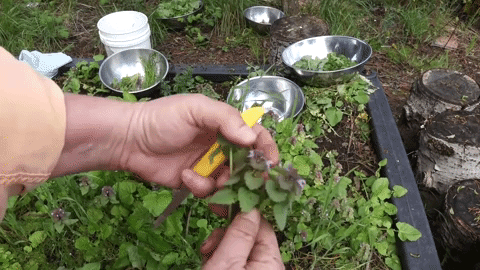.gif)

Tip 3: High-Grade
In picking garden weeds, we don't have to take everything. They're weeds, after all, so it's OK to high-grade, and just take the best plants back to the kitchen. Or the best plant parts.
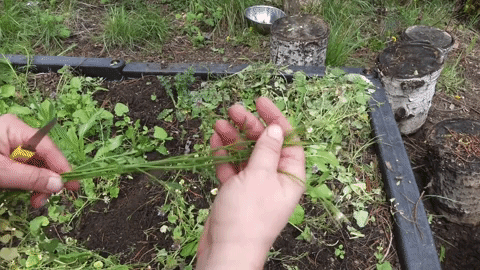.gif)
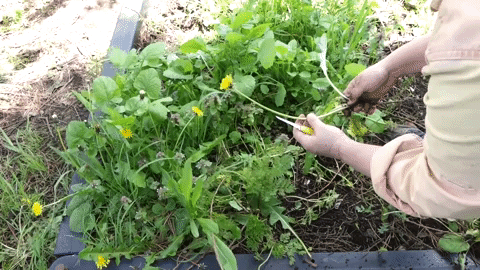.gif)

Tip 4: Learn to Identify a Lot of Weeds - Correctly!
There are so many wonderful weeds to eat. The more of them you get to know, the more food you can harvest! I am constantly amazed at how much food is all around us. And these plants are really tasty, too. It's not just for some imagined survival situation -- these plants are real food for regular people!
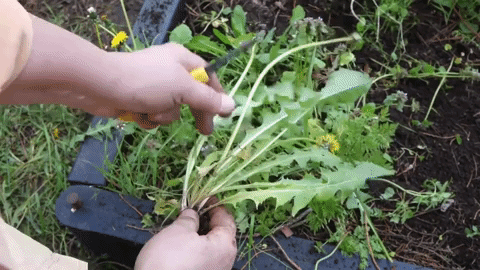.gif)
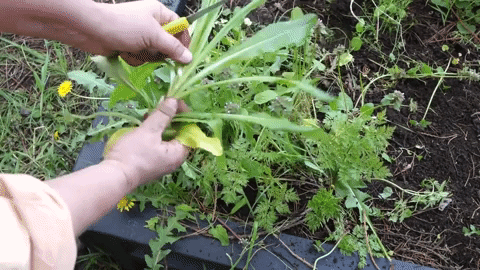.gif)
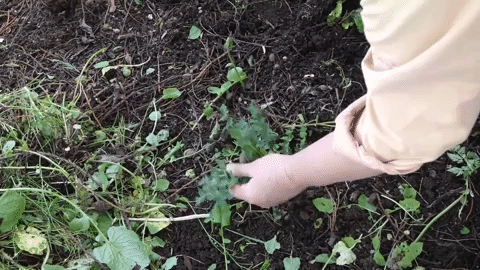.gif)

Tip 5: Watch Out for Poison Hemlock
This is one plant that every gardener should know. Poison hemlock causes a lot of trouble -- for gardeners more than foragers! I keep track of poison hemlock reports in the medical literature and newspaper articles. Poison hemlock gets mistaken for garden carrots, parsley, fennel, and even kale. By inattentive gardeners, but especially when non-gardeners are helping with a harvest. Those reports are tough to read!
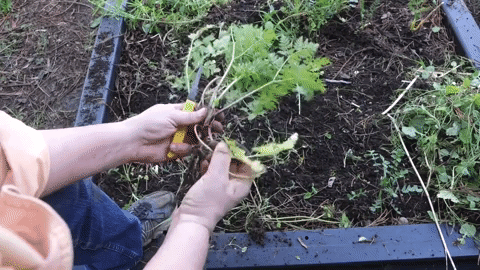.gif)
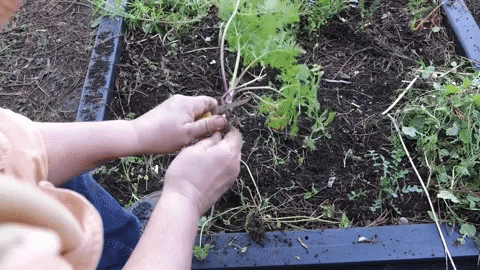.gif)

Enjoy Your Garden Weed Rewards!
It takes time for newly planted gardens to produce their crops. It's really satisfying to get an immediate reward -- even before planting anything! After clearing out my raised bed, it's all ready to plant now. And I've got a big batch of delicious wild greens to eat, too! Enough for days!
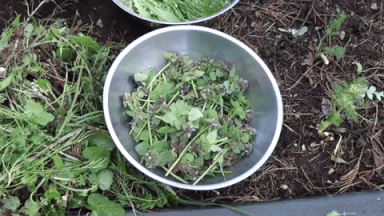.gif)
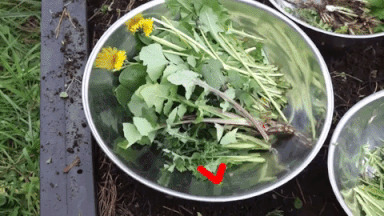.gif)
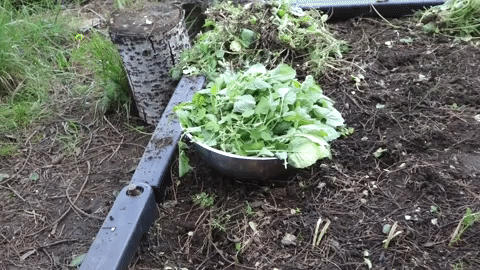.gif)

What Do You Think?
- Do you have any weeds in your garden?
- Do you eat any of your garden weeds?
- Do you know any of these weeds?
- Would you eat my weeds?
I eat a lot of wild plants and show you how, because I believe that we can all have lives that are richer, more secure, more grounded, and more interesting by getting to know the plants and the land around us – in our yards, our parks, and our wild places.
I try to make content that's interesting! If you found this informative and helpful, please give it an upvote and a resteem.

Plant List
- Nipplewort - Lapsana communis
- Dandelion - Taraxacum officinale
- Common Sowthistle - Sonchus oleraceus
- Prickly Sowthistle - Sonchus asper
- Prickly Wild Lettuce - Lactuca serriola
- Hedge Mustard - Sisymbrium officinale
- Cleavers, Stick-Tights, and lots of other names - Galium aparine
- Bristly Hawksbeard - Crepis setosa
- Bittercress - Cardamine hirsuta
- Purple Deadnettle - Lamium purpureum
- Wild Carrot, Queen Anne's Lace - Daucus carota
- Poison Hemlock - Conium maculatum - DO NOT EAT!
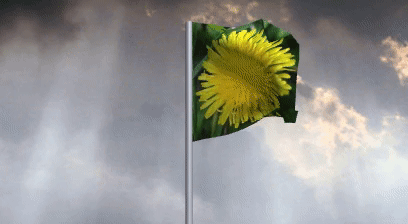
Great post, HH:)
I am very fortunate in the building where I live. There is a gardener and she plants us lots of edible herbs. My son has been snacking on the anise greens, just grabbing and branch and chomping down. He says it tastes just like candy. I agree it is rather tasty. I will be on a lookout for the poisonous hemlock. I will show him so he ever mistakes it for food. So important that we know the plants that can hurt us.
My dad always said, "If you can't have your own garden, cultivate a friendship with a gardener. " You've got a good deal with your own gardener! : ) And it's nice that your son is appreciating some fresh-grown herbs, especially some of the unusual ones, like anise. Folks that have access to community gardens really should be more aware of Poison Hemlock. There's really a 2-sided lesson. One side is that not everything growing in a garden is OK to eat, like rhubarb leaves or potato tops, or poison hemlock. The other side is that some weeds are as good to eat as anything people are trying to grow.
Excellent post!
I can find sow thistle a couple weeks out of the year. Queens Anne's lace is the one we have that looks like hemlock, but I haven't seen hemlock around. I think it may be too dry at this location for hemlock to survive.
Common purslane doesn't make it but 'horse purslane' will. Plantain is another I see on occasion.
Happy harvesting.
The sowthistles are some of my favorites! I'll have to look for that horse purslane when I'm in the right habitat. I don't know that one - and doing some quick research, it looks like I should! :D Yes, the poison hemlock likes some moisture, although it tolerates 3 months with almost no rain every summer, here in Oregon's Willamette Valley. Happy foraging!
Dude these gifs in here :) I absolutely LOVE them and they enhance the post so much.
But you are not deliberating planting these weeds right? These are just the ones that end up in between, am I correct. I really need a garden back when I see this...
I didn't plant any of these weeds - ever. They just blew in on the breeze or from birds. There have got to be so many weed seeds in the soil, just waiting for their chance!
que maravillas todas estas información ,a mi me encanta el jardín con estas plantas tan utiles
Thanks, @gladysob. If all the weeds were edible and tasty like these, it would be wonderful, lol. At least a lot of them were good! Happy gardening!
I am all about the edible weeds. The earth has so many gifts for us that people have forgotten. Thanks for this awesome post!
You would like the dandelions here in western Oregon, @carolynstahl! They are huge and delicious for months, where they grow in the shade or tall grass. So many of these plants are not originally from here, but were brought over as food plants. Some are even better eating than garden-grown greens, but they just don't stand up to shipping or holding for the markets. Enjoy your greens! : )
Wow the gifs are really a nice touch and helped me understand what I was reading better. Interesting. I swear I have seen that Poison hemlock before! The leaves seem to resemble small wild carrots leaves.
Thanks for that feedback, @old-guy-photos. I'm never sure whether the extra bandwidth of the GIFs is worth it for folks. I bet you have seen that Poison Hemlock. I know it's all over southern Michigan! I had it in my own gardens there. It likes disturbed areas. It gets pretty big - I've seen it over 6 feet tall. There's no mistaking it for a carrot then. But when it's young, that's the biggest concern.
I am going to look around this week, what I can find. This is an incredible information my Dear. You put so much time and effort not only harvesting, but also recording it all for us. Great job as always 🍒 🍌🍑🌿🍍🍓🍇

Thanks, @lenasveganliving! Eating well doesn't have to be expensive, with so many wonderful wild plants around us. Enjoy your fruits and veggies! :D
That is so true my Dear..............always a pleasure and thank you too 🌸💖🌸
CONGRATULATIONS! A WELL-EARNED AWARD!

I remember growing up in an Italian family the old Italians would eat dandelion and some other wild plants that slips my memory now. I also remember my uncle taking me mushroom hunting. They would only go after one type of mushroom they knew very well that always grew on old oak tree stumps. They were usually very large. I'd be afraid to to take a chance on that since I can't remember what they looked like. All the old timers are gone now so I guess I'll never get those mushrooms again.
I'm glad you got to experience that in your youth, @garden-to-eat. Some of these weeds that I eat, like the Crepis setosa are native to the Mediterranean region and still eaten there today, by the old-timers. So they may be the same as the ones you ate, too.
I wonder what mushrooms your uncle was hunting! I eat a lot of different wild mushrooms. You can always learn the mushrooms yourself and then enjoy them. But you are smart to not try hunting them based on distant memories. In reading reports of mushrooms poisonings, that's a common situation. Someone remembers a mushroom from their youth, going out with older relatives, but they haven't foraged for it for years. The other common situation is folks that foraged a specific mushroom on one continent, like Europe, but then they move to another continent and find a mushroom that looks like one back home. But it is never too late to learn wild plants and mushrooms. They are out there -- waiting for you! :D
I already said that, but I will repeat: it is not terrible to survive with you in the wild! :)
Thanks, @yetaras! There are so many plants worth eating, just growing wild out there. Every time I look, I am surprised at how many I see - and how much there is to harvest.
You give me always something new and very useful in your post! Extra practical fotos complement it :) Good for beginners,too!
Thanks, @liltammy. I"m glad you get something useful from my posts. There are so many wonderful plants to get to know! :D